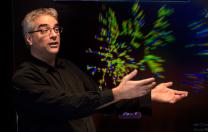In the diagram shown here, connections are drawn between words differentiated by a single sound--a framework that has helped researchers understand how humans process language. In a test designed to take users to the tip-of-the-tongue state (where they are at the edge of being able to recall a word), people had an easier time retrieving words that were “well-connected”--those with a high number of words that sound similar. For example, subjects had a harder time generating the word pub when asked, “What is the British word for a drinking establishment?” than they did generating bail when asked for the verb that means remove water from a boat. (Although some words--stub, hub, grub--sound similar to pub, many more rhyme with bail: sail, jail, mail, tail, hail, fail, nail, pail, as well as the numerous like-sounding words ending in -ale.)
In subsequent research, Samuel Arbesman, a postdoctoral fellow with a background in computational biology working in Nicholas Christakis’s lab, joined psychologist Michael Vitevitch of the University of Kansas and mathematician Steven Strogatz of Cornell in comparing languages and found that this basic principle--words that are well-connected are easier to generate--was universally true, but truer of some languages than others. For example, the pattern was less pronounced in Spanish than in English: having many similar-sounding words helped less in Spanish than it did in English. The researchers believe this is due to the intrinsic properties of the languages themselves.
In Spanish, words that sound similar tend to mean similar things. To take a simple example, acendrado and acendrada are masculine and feminine versions of the same word, pure. In English, on the other hand, words that sound similar often have vastly different meanings (think of necklace and reckless). This is partly due to the diverse linguistic influences on English (from Romance as well as from related Germanic languages, for example). In addition, English uses inflection less than Spanish--so where English would add an extra word, Spanish often adds just a suffix: for instance, Ella volverá for She will come back (based on the infinitive volver, “to come back”).
In English, as one might predict, people had an easier time generating words that lay on “well-traveled” phonetic paths in the brain. But in Spanish, the researchers theorize, there seem to be so many words that are not only similar phonetically but also have similar meanings that the brain simply gets mixed up.
When the researchers moved from speech production to speech comprehension, they saw the trends reverse. They tested speech comprehension by measuring people’s language-processing speed (for instance, how quickly they decided whether a snippet of speech was a real word or nonsense) and processing accuracy (for instance, people’s facility in accurately hearing words played against background static). In these speech-comprehension tests, having lots of similar-sounding words seemed to get in the way of remembering the right word for English speakers--perhaps precisely because the meanings were so often different even when the sounds were the same. For Spanish speakers, having lots of similar-sounding words was helpful for speech comprehension. The investigators therefore concluded that having lots of similar-sounding words makes both speech production and speech comprehension easier in general, but the degree of benefit varies depending on specific attributes of individual languages.
The three researchers also discovered that language networks have another interesting quality. The networks for all the languages they studied (Basque, Mandarin, and Hawaiian, as well as English and Spanish) are assortatively mixed: high-degree nodes tend to be connected to other high-degree nodes. In these languages, a given word tends to be linked to other words that are themselves linked to an above-average number of words.
Most of the types of networks that scientists study--the Internet, transportation networks, networks of neurons--are disassortatively mixed: nodes that are dissimilar in terms of degree are connected to each other. For example, a wireless Internet router may have several computers connected to it, but it’s less common for routers themselves to be connected to each other. An air traveler starting out at a small airport can’t fly to another small airport without connecting at an airline hub. If your leg itches, you can’t scratch it unless the stimulus travels first to your central nervous system and then back out to the periphery, lightning-fast though that process may be--the peripheral neurons are not directly connected to each other.
Human social networks, on the other hand, are one of the few types of well-known networks that are assortatively mixed. In other words, people who know a lot of people are also likely to know each other. (With disassortative mixing, a person with many friends would mostly be friendly with hermits.)
Linguistic networks’ structure, then, coincides neatly with language’s status bridging the biological and the social. And in addition to helping scientists understand language production and comprehension, the network approach is helping them understand the effects of events that damage the brain, such as strokes. Using a method common in network analysis--removing nodes and testing how “robust” the rest of the network is, i.e., what proportion of its nodes are still linked to each other--points toward approaches to rehabilitation. At heart, says Arbesman, network methods are helping scientists understand the evolutionary pressures that shaped the human mind.








